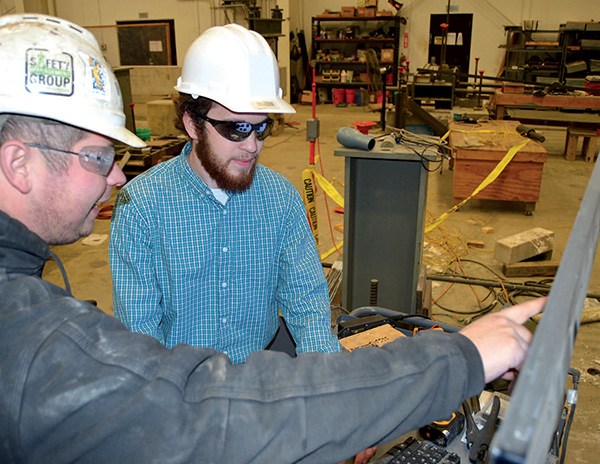Training ground for hazards engineers
Researchers at Purdue's Bowen Lab train and employ undergraduate researchers
The Lyles School of Civil Engineering strives to make every avenue available for undergraduate students to participate in meaningful research — and that includes opportunities at the Robert L. and Terry L. Bowen Laboratory for Large-Scale Civil Engineering Research.
The 66,000-square-foot Bowen Laboratory is home to research and investigations on the behavior of large structural models and elements subjected to loads representing extreme events, such as earthquakes, blasts and impact. With the knowledge gleaned, engineers can design future structures to better withstand extreme events.
The lab also serves as an invaluable and unique educational resource. Outside of Purdue, few civil engineering undergraduates will get a chance to use equipment such as a strong floor, earthquake simulators and hybrid simulation facilities. From preparing materials for testing to analyzing data, undergrads at the Bowen Lab are involved in just about every stage of research.
Amit Varma, the Karl H. Kettelhut Professor of Civil Engineering and director of the Bowen Laboratory, says a core mission of both the lab and the school is to serve the students.
"The involvement of undergrads is central to our educational mission," Varma says. "All too often at other schools, labs and universities, it is rare to include undergrads in meaningful research. But times have changed. Our students have proven to be invaluable. They bring in fresh ideas and are incredibly eager to learn."
Joshua Harmon and Rob Singer, civil engineering seniors and research assistants at the Bowen Lab, say they feel as if their overall knowledge and understanding of civil engineering have taken giant leaps forward, thanks to their experiences here.
"I definitely feel that this sets Purdue Civil Engineering apart from other schools," says Harmon, who has been assisting with research on seismic and wind behaviors and on the design of concrete-filled composite plate shear walls. "What I have learned here in just one semester has put me much further ahead than if I had only attended classes for my studies."
"It's also been a great way for me to get a jump-start on grad school," adds Singer, who has been assisting with research on performance-based fire engineering of steel and composite building structures. "And it is certainly something that looks impressive on any résumé."
The benefits gained from undergraduate participation are hardly one-sided. Thomas Bradt, Bowen Laboratory project researcher, says the vital assistance provided by students makes research endeavors at Bowen go more smoothly.
"The students definitely help make our jobs a lot easier," Bradt says. "They take their work very seriously, and their enthusiasm to assist and learn on the job is infectious. The opportunities and relationships our school and lab provide undergraduate students sets us apart from pretty much every other school out there."
To learn more about the research and research opportunities at Bowen Laboratory, visit engineering.purdue.edu/Bowen.

Bowen Laboratory project researcher Thomas Bradt (left) and Purdue Civil Engineering undergraduate student Joshua Harmon (right) examine load versus displacement data on web bending of a wide flange beam loaded in compression.
